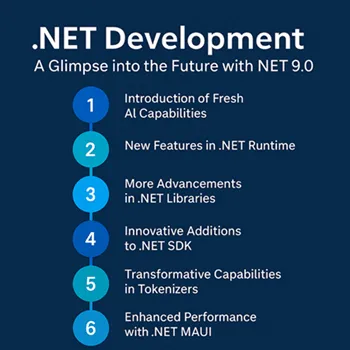Why Dot NET Development is Still the Gold Standard for Enterprise Software in 2025

The Time-Tested Scope of .NET Technology:
Since its introduction by Microsoft in the early 2000s, .NET has grown from a Windows-only development framework into a cross-platform, open-source development ecosystem. In 2025, it supports application development for the web, mobile, desktop, cloud, gaming, IoT, and AI—making dot net development services one of the most versatile and reliable choices for modern businesses.
.NET continues to lead in enterprise software development by combining long-term stability with cutting-edge innovations, especially with the release of .NET 9.0, which pushes the boundaries of what developers can do with AI, performance, and security.
.NET Development: A Glimpse into the Future with .NET 9.0:
With the release of .NET 9, Microsoft has once again proven its commitment to delivering powerful, secure, and developer-friendly tools. Here's what the future looks like for businesses investing in dot net development:

1. Built-In AI Capabilities
.NET 9 introduces AI integrations through the Microsoft.Extensions.VectorData and Microsoft.Extensions.AI packages. It supports new tensor types, allowing developers to process multidimensional data for AI and machine learning tasks with ease.
2. Runtime Enhancements
.NET 9 adds feature switches with attribute models, trimming support, and dynamic garbage collection based on application size—delivering faster runtime performance and efficient memory usage.
3. Improved .NET Libraries
The latest System.Text.Json enhancements allow developers to extract JSON schemas, read multiple values, and manage JSON indentation in a streamlined way.
4. Smarter SDK Management
The SDK now includes workload sets, giving teams better version control and runtime flexibility—essential for long-term project maintenance.
5. Enhanced Tokenizer Framework
Developers can now use tokenizers for GPT and Llama models, enabling the use of AI-powered language models directly in .NET applications.
6. MAUI Performance Upgrades
.NET MAUI improvements ensure faster startup times and smaller app sizes for cross-platform apps across desktop and mobile.
Is .NET Still Good for Enterprise Applications in 2025?
Absolutely with its seamless integration of AI, cloud-native design, cross-platform support, and a huge developer ecosystem, .NET remains a top-tier framework for enterprise solutions.
By partnering with experienced .NET development services providers, businesses can:
- Build cloud-native, scalable solutions with Azure and Kubernetes.
- Modernize legacy systems using .NET Upgrade Assistant.
- Develop robust web, mobile, and desktop apps using a single codebase.
Leverage tools like Visual Studio, GitHub Copilot, and IntelliCode for predictive, intelligent coding.
Key Trends Shaping Dot Net Development Services in 2025:
1. AI & ML Integration with ML.NET 1.4
With ML.NET 1.4, developers can embed machine learning directly into applications for predictive analytics, fraud detection, personalization, and more.
2. Blazor Framework for Dynamic Web UIs
Blazor allows C# developers to build interactive front-end experiences without relying on JavaScript. It’s ideal for applications like healthcare portals and internal dashboards.
3. Xamarin for Unified Mobile App Development
Xamarin enables the development of high-performance apps for iOS and Android from a single codebase, reducing costs and boosting time-to-market.
4. Azure Kubernetes Service (AKS) for Cloud Scalability
AKS empowers businesses to manage containerized apps with ease, making it perfect for platforms requiring on-demand scalability.
5. ASP.NET Core & Docker for Microservices
Docker and ASP.NET Core enable modular architectures where independent microservices can scale and deploy effortlessly.
6. Enterprise-Grade Security
.NET ensures advanced application security with features like control-flow protection, memory access checks, secure authentication, and Azure Active Directory integration.
7. Open Source & Cross-Platform Flexibility
.NET’s evolution as a cross-platform, open-source technology fosters a collaborative ecosystem and supports development on Windows, macOS, and Linux.
8. Azure Integration for Cloud-Native Dev
Azure offers deep integrations with .NET—ideal for deploying serverless apps, managing cloud resources, and ensuring cost efficiency.
9. IoT & Edge Computing
.NET supports real-time data processing from connected devices, making it suitable for edge computing and IoT applications.
10. Productivity-Driven Tooling
Tools like Visual Studio 2025, GitHub Copilot, and IntelliCode streamline development with features like intelligent code suggestions and advanced debugging.
11. Legacy Framework Support
.NET Framework 4.8 remains in mainstream support through 2029, ensuring continuity for businesses running older applications while allowing gradual migration to .NET Core or .NET 9.
12. Strong Developer Community & Learning Resources
The .NET community is thriving, with forums, GitHub repositories, Microsoft Learn resources, and regular updates—creating an ideal environment for innovation and learning.
The Business Value of Dot Net Development Services in 2025:
By embracing dot net development services, businesses can unlock:
- Faster time-to-market with prebuilt tools and AI-powered features.
- Lower maintenance costs via reusable code and smart debugging.
- Seamless modernization of legacy systems with minimal risk.
- Enterprise-grade performance backed by .NET 8 LTS and .NET 9 innovations.
Agile integration with cloud environments for scalable deployments.
Final Thoughts: The Future is Bright with .NET:
In 2025, .NET stands as both a legacy platform with proven reliability and a modern framework driving innovation. Whether you're scaling a SaaS platform, transforming a healthcare system, or modernizing legacy ERP software, investing in dot net development services will ensure your enterprise stays secure, scalable, and competitive in a rapidly evolving digital world. Contact us today!


Comments